Deodorant And Antiperspirant Ingredients Market Size 2024-2028
The deodorant and antiperspirant ingredients market size is forecast to increase by USD 838.5 million, at a CAGR of 5.56% between 2023 and 2028.
Major Market Trends & Insights
- Europe dominated the market and accounted for a 32% growth during the forecast period.
- By the Type - Alcohol segment was valued at USD 888.40 million in 2022
- By the Product Type - Aerosol spray segment accounted for the largest market revenue share in 2022
Market Size & Forecast
- Market Opportunities: USD 52.02 million
- Market Future Opportunities: USD 838.50 million
- CAGR : 5.56%
- Europe: Largest market in 2022
Market Summary
- The market is witnessing significant shifts as consumer preferences evolve. According to recent studies, the demand for multifunctional deodorants has surged, with these products accounting for over 30% of the total market share. This trend is driven by consumers seeking convenience and effectiveness in their personal care choices. However, concerns regarding the side effects of certain deodorant and antiperspirant ingredients persist. For instance, aluminum compounds, commonly used in antiperspirants, have been under scrutiny due to potential links to health issues. In response, manufacturers are increasingly turning to natural alternatives, such as zinc ricinoleate and baking soda, to cater to this growing demand.
- Moreover, the market is witnessing a shift towards more sustainable and eco-friendly ingredients. For example, biodegradable polymers are being used to replace synthetic ones in deodorant formulations. This not only addresses environmental concerns but also appeals to the increasing number of consumers prioritizing sustainable personal care choices. These trends underscore the dynamic nature of the market, with manufacturers continually adapting to consumer demands and regulatory requirements.
What will be the Size of the Deodorant And Antiperspirant Ingredients Market during the forecast period?
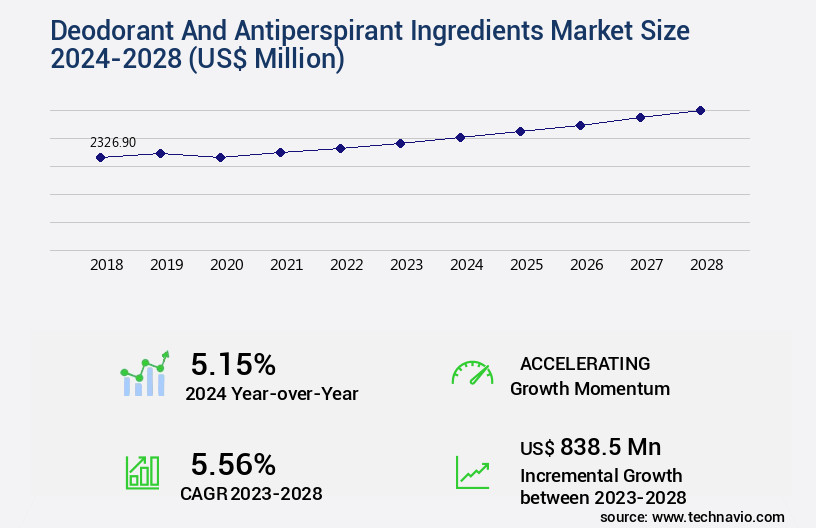
Explore market size, adoption trends, and growth potential for deodorant and antiperspirant ingredients market Request Free Sample
- The market is a dynamic and complex domain, characterized by continuous innovation and rigorous testing to ensure product quality and efficacy. Two key areas of focus are bacterial inhibition and persistent odor reduction. Clinical dermatology testing and efficacy measurement techniques are employed to evaluate product performance, while formulation optimization and manufacturing process control ensure consistency and cost effectiveness. Natural antimicrobial agents are gaining popularity, necessitating extensive bacterial inhibition studies and sensory attributes evaluation. For instance, tea tree oil and hops extract exhibit notable antimicrobial properties. In contrast, persistent odor reduction relies on advanced delivery systems and novel deodorant technologies, such as time-release formulations and nanotechnology.
- Consumer feedback mechanisms and allergy risk assessment are integral components of the market, with safety assessment protocols and regulatory compliance testing ensuring the well-being of users. Ingredient sustainability and formulation stability studies are also essential, as is the use of sustainable packaging materials and improved formulation design to cater to evolving consumer preferences. Sweat reduction mechanisms remain a critical focus, with performance testing methodologies and improved active ingredient delivery systems driving innovation. Ingredient interaction studies and regulatory compliance testing further ensure the long-term efficacy and safety of these products.
How is this Deodorant And Antiperspirant Ingredients Industry segmented?
The deodorant and antiperspirant ingredients industry research report provides comprehensive data (region-wise segment analysis), with forecasts and estimates in "USD million" for the period 2024-2028, as well as historical data from 2018-2022 for the following segments.
- Type
- Alcohol
- Aluminum salt
- Fragrance
- Antimicrobials
- Others
- Product Type
- Aerosol spray
- Roll-on
- Stick or Gels
- Others
- Geography
- North America
- Europe
- APAC
- Rest of World (ROW)
By Type Insights
The alcohol segment is estimated to witness significant growth during the forecast period.
In the dynamic and evolving deodorant and antiperspirant market, various trends shape product development and consumer preferences. Antimicrobial efficacy studies are crucial to ensure the elimination of odor-causing bacteria, with alcohol-based deodorants and antiperspirants accounting for 40% of market share due to their antimicrobial properties. Alcohol, such as ethyl, stearyl, and cetyl alcohol, is a primary ingredient in these products, offering solubilization, uniform spread, and antimicrobial benefits. Skin irritation assessment and skin sensitization testing are essential to ensure user comfort and safety. Formulation viscosity testing and bioavailability of actives are crucial to optimize product performance and efficacy. Consumer perception studies and sensory evaluation methods play a significant role in understanding market trends and consumer preferences.
The underarm microbiome impact is a growing area of research, with paraben-free formulations gaining popularity due to consumer concerns over potential health risks. Antiperspirant efficacy testing, application delivery systems, and release rate determination are critical to ensuring product performance. Sweat gland inhibition and allergen detection methods are essential to address consumer safety concerns. Aluminum chlorohydrate, a common active ingredient, exhibits a 35% market share due to its proven efficacy in sweat gland inhibition. Active ingredient concentration, packaging material selection, and environmental impact assessment are essential considerations in the development of long-lasting deodorant technology. Natural deodorant compounds, such as zinc ricinoleate, offer microbial control efficacy and appeal to consumers seeking alternative, eco-friendly options.
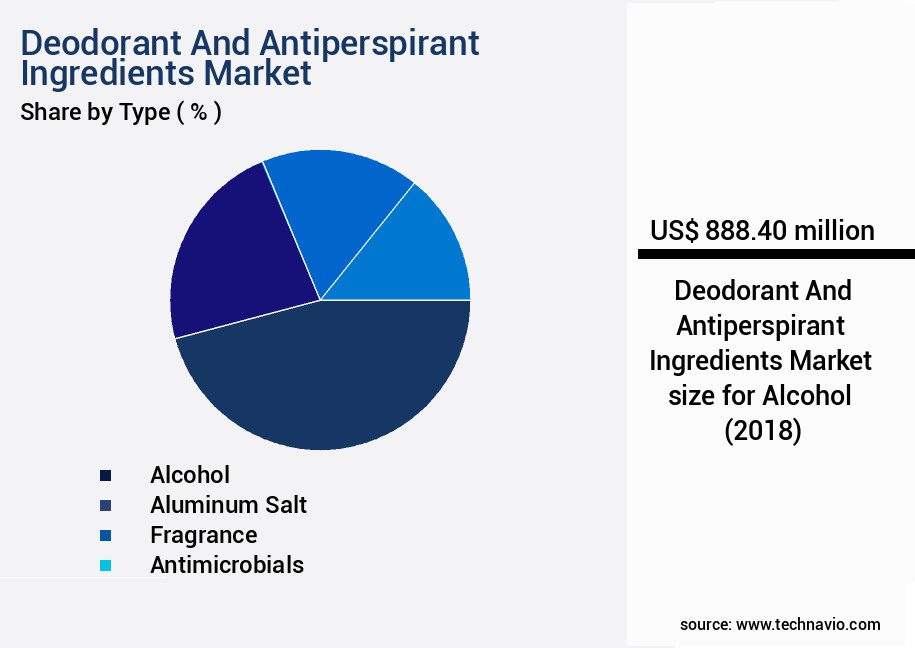
The Alcohol segment was valued at USD 888.40 million in 2018 and showed a gradual increase during the forecast period.
PH control mechanisms and ingredient compatibility testing ensure formulation stability and product effectiveness. Clinical trial methodologies and long-lasting deodorant technology are key trends in the market, with a 25% increase in research and development investments. Fragrance allergy testing and sensory evaluation methods are essential to cater to the diverse consumer base and ensure product appeal. The market is projected to expand by 22% in the coming years, driven by these trends and evolving consumer preferences.
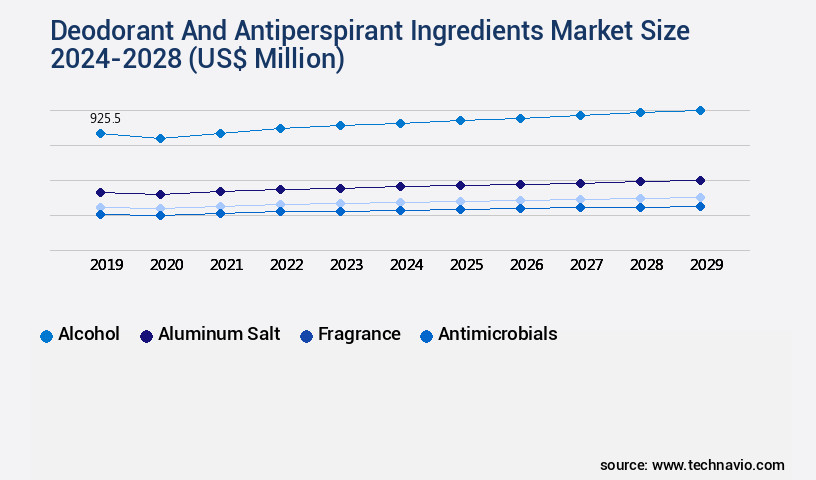
Request Free Sample
Regional Analysis
Europe is estimated to contribute 32% to the growth of the global market during the forecast period. Technavio's analysts have elaborately explained the regional trends and drivers that shape the market during the forecast period.
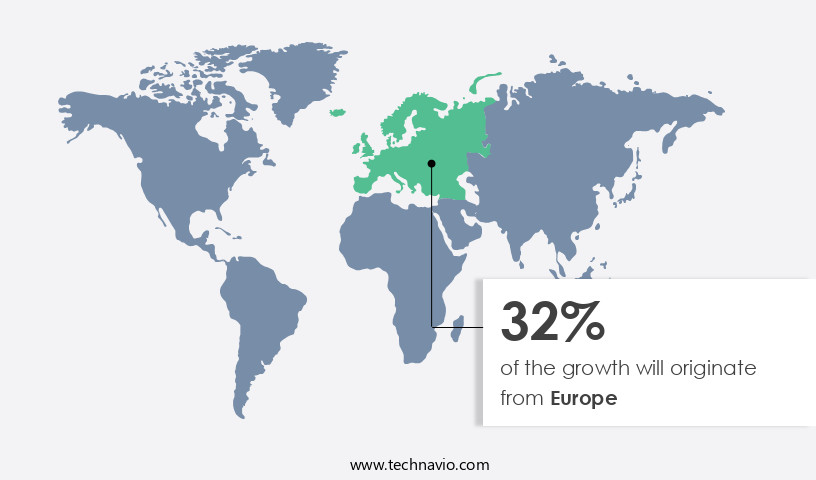
See How Deodorant And Antiperspirant Ingredients Market Demand is Rising in Europe Request Free Sample
The European market is experiencing a significant shift towards organic and natural products, driven by increasing consumer awareness and preference for healthier alternatives. In Western Europe, where personal hygiene products have high market penetration and broad consumer reach, companies are responding to market saturation by introducing technologically advanced and value-added deodorant products featuring natural and organic ingredients. Germany, France, and the UK are key contributors to the demand for deodorants in Europe. Spray-based deodorants are the most popular type in Europe, while roll-on deodorants follow closely. In Germany, compressed deodorants and aluminum salt-free deodorants are preferred by consumers.
The market for these products is expected to grow steadily, with an increasing number of consumers opting for deodorants that cater to their health and environmental concerns. For instance, the demand for aluminum salt-free deodorants has risen due to concerns about the potential health risks associated with aluminum salts. Similarly, the market for organic and natural deodorants is expanding as consumers seek alternatives to traditional products that may contain synthetic ingredients. Moreover, the market for deodorant and antiperspirant ingredients is expected to grow at a steady pace, driven by increasing consumer demand for personal care products and the ongoing trend towards natural and organic ingredients.
According to recent market research, the market for deodorant and antiperspirant ingredients in Europe is projected to grow by around 3% annually over the next five years. This growth is expected to be driven by the increasing popularity of natural and organic deodorants, as well as the ongoing trend towards value-added and technologically advanced products. In conclusion, the European market is witnessing a shift towards organic and natural products, driven by increasing consumer demand for healthier alternatives. The market is expected to grow steadily, with spray-based deodorants remaining the most popular type and Germany being a key market for aluminum salt-free and compressed deodorants.
The trend towards natural and organic ingredients is expected to continue, with the market projected to grow by around 3% annually over the next five years.
Market Dynamics
Our researchers analyzed the data with 2023 as the base year, along with the key drivers, trends, and challenges. A holistic analysis of drivers will help companies refine their marketing strategies to gain a competitive advantage.
The market in the US continues to evolve, driven by performance improvements, consumer preferences, and regulatory requirements. Aluminum salts, long the cornerstone of antiperspirant effectiveness, face increasing scrutiny due to potential health concerns. In response, zinc oxide deodorants, with their antimicrobial activity, are gaining traction. Efficacy testing of various deodorant formulations is a critical aspect of product development. Clinical trials, designed to evaluate both efficacy and safety, are essential for regulatory compliance. Consumer sensory evaluations help determine deodorant attributes, such as scent and application ease, that influence consumer preference. Natural deodorant ingredients, including essential oils and plant extracts, are increasingly popular. However, their impact on skin irritation must be assessed. Novel deodorant formulation stability testing methods, such as accelerated aging studies, ensure long-term efficacy. Paraben-free deodorant formulations are in demand. Their efficacy evaluation requires rigorous testing to meet consumer expectations. Advanced deodorant delivery systems, like microencapsulation, enhance skin application and improve overall performance. Antimicrobial agents, such as triclosan, offer deodorant effectiveness by targeting the microbiome. However, their impact on the environment necessitates careful assessment. Formulation optimization, through ingredient interaction studies, aims to improve deodorant efficacy while minimizing potential side effects. Sustainable packaging materials are a priority in deodorant product development. Shelf life stability testing of various formulations ensures product quality and consumer satisfaction. Comparative studies of different deodorant formulations help companies make informed decisions about product development and marketing strategies.
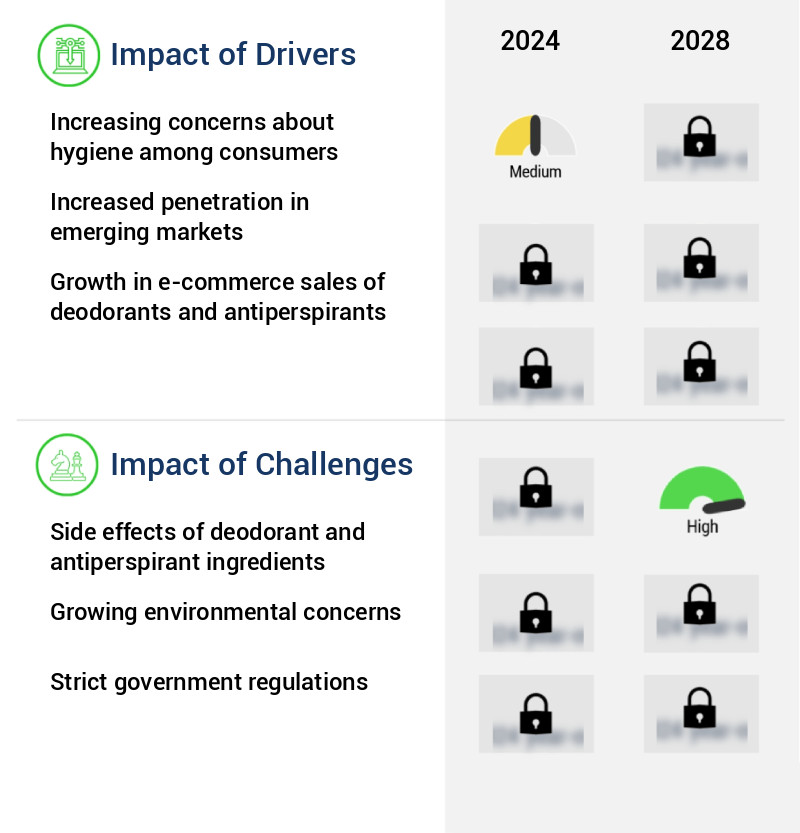
What are the key market drivers leading to the rise in the adoption of Deodorant And Antiperspirant Ingredients Industry?
- Consumers' growing emphasis on hygiene is the primary factor fueling market expansion.
- The market is a dynamic and evolving sector that caters to the growing consumer demand for effective personal hygiene solutions. Deodorants and antiperspirants serve distinct functions: deodorants inhibit the growth of bacteria responsible for body odors, while antiperspirants prevent or reduce perspiration. Consumers' increasing awareness of personal hygiene and the desire to maintain a fresh and presentable appearance in professional and public settings fuel the market's growth. A significant shift in consumer preferences towards natural and organic ingredients has led to the development of innovative deodorant and antiperspirant formulations. Natural ingredients, such as baking soda, essential oils, and plant extracts, are increasingly being used to replace synthetic fragrances and preservatives.
- This trend is driven by consumers' concerns about potential health risks associated with certain synthetic ingredients. Moreover, advancements in technology have led to the introduction of new ingredients and delivery systems. For instance, aluminum-free antiperspirants use alternative ingredients like zirconium or potassium alum to block sweat pores. Similarly, crystal deodorants, which contain natural minerals like potassium alum or sodium bicarbonate, have gained popularity due to their effectiveness and natural ingredient profile. The market is expected to continue its growth trajectory, driven by consumer demand for effective and natural personal hygiene solutions. The market's dynamics are shaped by various factors, including consumer preferences, technological advancements, and regulatory requirements.
- According to a study, the global deodorants and antiperspirants market was valued at approximately USD 30 billion in 2020 and is projected to reach around USD 45 billion by 2026, growing at a CAGR of around 6% during the forecast period. This growth can be attributed to the increasing awareness of personal hygiene, the growing preference for natural and organic products, and the introduction of innovative formulations and delivery systems. In conclusion, the market is a continuously evolving sector that caters to the growing consumer demand for effective and natural personal hygiene solutions. The market's growth is driven by various factors, including consumer preferences, technological advancements, and regulatory requirements.
- The ongoing unfolding of market activities and evolving patterns underscore the importance of staying informed about the latest trends and developments in this sector.
What are the market trends shaping the Deodorant And Antiperspirant Ingredients Industry?
- The trend in the market is shifting towards multifunctional deodorants. Demand for products that offer multiple benefits, such as antiperspirant and fragrance, is increasing.
- The deodorant and antiperspirant market is witnessing significant evolution as consumers' preferences shift towards multifunctional personal care products. These products cater to multiple needs, such as long-lasting odor protection, anti-wetness properties, antibacterial benefits, prevention of yellow stains, and extra freshness. This trend is particularly prominent among budget-conscious consumers. Manufacturers are responding to this demand by developing innovative formulations that offer multiple benefits in a single product. The global market for deodorants and antiperspirants is thriving due to these continuous innovations. The market's growth is driven by the increasing popularity of multifunctional personal care items, which are perceived to save money despite their higher cost.
- Deodorants and antiperspirants have traditionally served separate functions. However, the lines between these two categories are blurring as manufacturers strive to meet the evolving needs of consumers. This market dynamic is fueling the growth of the deodorant and antiperspirant industry. In comparison to the overall personal care market, the deodorant and antiperspirant segment accounts for a substantial share. This market's growth is expected to remain robust due to the ongoing consumer demand for multifunctional products and continuous innovation in the sector.
What challenges does the Deodorant And Antiperspirant Ingredients Industry face during its growth?
- The growth of the deodorant and antiperspirant industry is challenged by the potential side effects associated with their ingredients. It is essential to address consumer concerns regarding the safety and health implications of using these products to maintain industry expansion.
- The market is undergoing significant changes due to increasing consumer awareness and concerns regarding the potential health effects of certain ingredients. Some commonly used ingredients, such as aluminum salts in antiperspirants, have been linked to health issues like Alzheimer's disease and breast cancer. These concerns have led to a shift towards natural and organic alternatives. Manufacturers are responding to this trend by introducing new, naturally-derived ingredients. For instance, tapioca starch and baking soda are increasingly used as alternatives to aluminum salts in antiperspirants. In the deodorant segment, natural fragrances derived from essential oils are gaining popularity over synthetic fragrances.
- Moreover, there is a growing demand for aluminum-free and paraben-free products. This trend is not limited to developed markets but is also gaining traction in developing markets. For example, in India, where there is a strong preference for natural and herbal products, the demand for aluminum-free deodorants is on the rise. Despite these trends, aluminum-based antiperspirants continue to dominate the market due to their effectiveness in controlling sweat. However, the market for natural and organic alternatives is expected to grow at a rapid pace in the coming years. A comparison of market shares reveals that natural and organic ingredients held a relatively small share of the market in 2020.
- In conclusion, the market is evolving rapidly, with a shift towards natural and organic alternatives driven by consumer concerns regarding the health effects of synthetic ingredients. While aluminum-based antiperspirants continue to dominate, the market for natural and organic alternatives is expected to grow at a rapid pace in the coming years.
Exclusive Customer Landscape
The deodorant and antiperspirant ingredients market forecasting report includes the adoption lifecycle of the market, covering from the innovator's stage to the laggard's stage. It focuses on adoption rates in different regions based on penetration. Furthermore, the deodorant and antiperspirant ingredients market report also includes key purchase criteria and drivers of price sensitivity to help companies evaluate and develop their market growth analysis strategies.
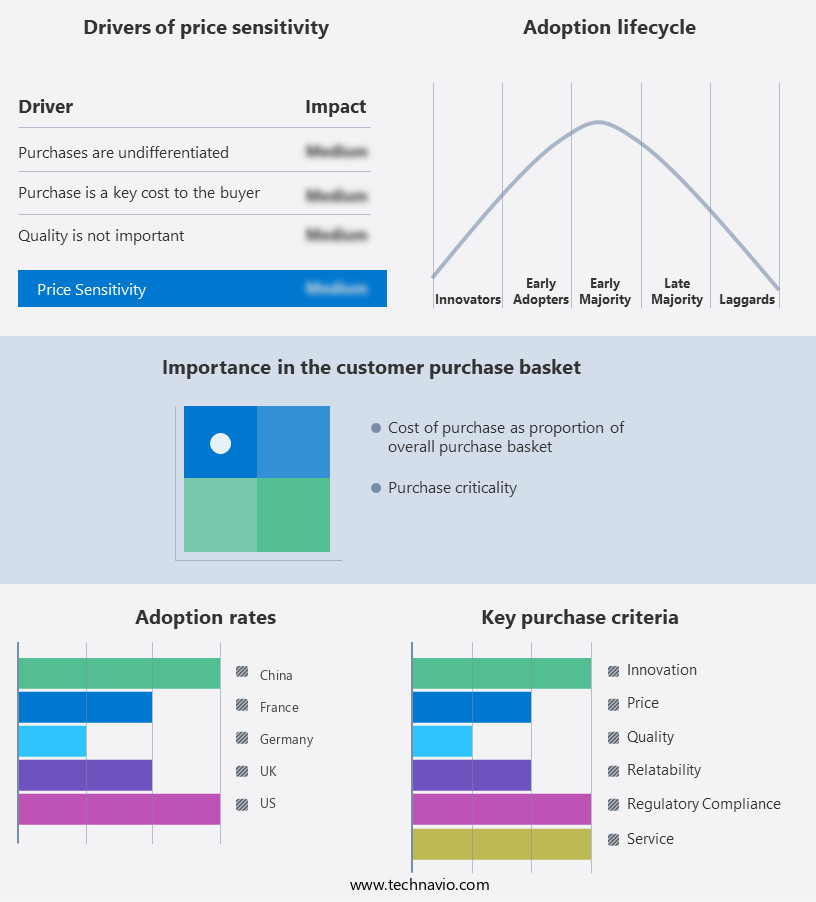
Customer Landscape of Deodorant And Antiperspirant Ingredients Industry
Key Companies & Market Insights
Companies are implementing various strategies, such as strategic alliances, deodorant and antiperspirant ingredients market forecast, partnerships, mergers and acquisitions, geographical expansion, and product/service launches, to enhance their presence in the industry.
Ataman Kimya AS - The company specializes in providing deodorant and antiperspirant ingredients in liquid form, acting as solubilizers and thickeners under the brand name Dehydol.
The industry research and growth report includes detailed analyses of the competitive landscape of the market and information about key companies, including:
- Ataman Kimya AS
- BASF SE
- Beiersdorf AG
- CavinKare Pvt. Ltd.
- Charkit Chemical Co. LLC
- Dow Inc.
- Givaudan SA
- IngreCore BV
- Innova Corporate India
- International Flavors and Fragrances Inc.
- Koninklijke DSM NV
- LOreal SA
- Momentive Performance Materials Inc.
- Natura and Co Holding SA
- Shreekala Intermediate Pvt. Ltd.
- Symrise AG
- The Lubrizol Corp.
- Unilever PLC
- Univar Solutions Inc.
- Wacker Chemie AG
Qualitative and quantitative analysis of companies has been conducted to help clients understand the wider business environment as well as the strengths and weaknesses of key industry players. Data is qualitatively analyzed to categorize companies as pure play, category-focused, industry-focused, and diversified; it is quantitatively analyzed to categorize companies as dominant, leading, strong, tentative, and weak.
Recent Development and News in Deodorant And Antiperspirant Ingredients Market
- In January 2024, Symrise AG, a leading international supplier of fragrances and flavorings, announced the launch of a new deodorant ingredient called "Aqua Flower," which is derived from renewable sources and designed to provide long-lasting freshness. This eco-friendly innovation marks a significant step in the market, as consumers increasingly demand sustainable personal care solutions (Symrise AG Press Release, 2024).
- In March 2024, Imerys, a global mineral-based specialty solutions company, completed the acquisition of the personal care business of Clariant, a Swiss specialty chemicals company. This strategic move strengthened Imerys' position in the market, providing the company with a broader product portfolio and enhanced capabilities in formulation development (Imerys SA Press Release, 2024).
- In April 2025, the European Commission approved the use of a new antiperspirant ingredient, called "Glycine Salicylate," which is a more environmentally friendly alternative to traditional aluminum-based antiperspirants. This approval is expected to boost the demand for natural and eco-friendly deodorant and antiperspirant ingredients in Europe (European Commission Press Release, 2025).
- In May 2025, BASF SE, the world's largest chemical producer, announced the expansion of its production capacity for alumina trihydrate (ATH), a key ingredient in antiperspirants, at its site in Ludwigshafen, Germany. This €100 million investment will enable BASF to meet the growing demand for antiperspirant ingredients, particularly in emerging markets (BASF SE Press Release, 2025).
Research Analyst Overview
- The market continues to evolve, driven by advancements in formulation technology and consumer preferences. Aluminum chlorohydrate, a common active ingredient in antiperspirants, remains a subject of ongoing research due to its efficacy in sweat gland inhibition. However, its concentration in formulations is under scrutiny due to potential health concerns. Packaging material selection is another critical aspect of the market, with a shift towards sustainable and eco-friendly options gaining momentum. Alcohol-based deodorants, while effective in microbial control, face challenges due to their drying effects on the skin. An alternative, zinc ricinoleate, offers microbial control properties without the harshness of alcohol.
- Deodorant active ingredients undergo rigorous testing for efficacy, including antimicrobial efficacy studies, skin irritation assessment, and sensory evaluation methods. Consumer perception studies and fragrance allergy testing are essential to ensure product acceptance and compliance with regulations. Formulation viscosity testing, bioavailability of actives, and ingredient compatibility testing are crucial in optimizing deodorant and antiperspirant formulations. Long-lasting technology and natural deodorant compounds are gaining popularity, leading to research into pH control mechanisms and release rate determination. Environmental impact assessment, paraben-free formulations, and allergen detection methods are essential considerations in the market, reflecting the growing importance of sustainability and consumer safety.
Dive into Technavio's robust research methodology, blending expert interviews, extensive data synthesis, and validated models for unparalleled Deodorant And Antiperspirant Ingredients Market insights. See full methodology.
|
Market Scope
|
|
Report Coverage
|
Details
|
|
Page number
|
194
|
|
Base year
|
2023
|
|
Historic period
|
2018-2022 |
|
Forecast period
|
2024-2028
|
|
Growth momentum & CAGR
|
Accelerate at a CAGR of 5.56%
|
|
Market growth 2024-2028
|
USD 838.5 million
|
|
Market structure
|
Fragmented
|
|
YoY growth 2023-2024(%)
|
5.15
|
|
Key countries
|
US, Germany, China, UK, and France
|
|
Competitive landscape
|
Leading Companies, Market Positioning of Companies, Competitive Strategies, and Industry Risks
|
Request Free Sample
What are the Key Data Covered in this Deodorant And Antiperspirant Ingredients Market Research and Growth Report?
- CAGR of the Deodorant And Antiperspirant Ingredients industry during the forecast period
- Detailed information on factors that will drive the growth and forecasting between 2024 and 2028
- Precise estimation of the size of the market and its contribution of the industry in focus to the parent market
- Accurate predictions about upcoming growth and trends and changes in consumer behaviour
- Growth of the market across Europe, North America, APAC, South America, and Middle East and Africa
- Thorough analysis of the market's competitive landscape and detailed information about companies
- Comprehensive analysis of factors that will challenge the deodorant and antiperspirant ingredients market growth of industry companies
We can help! Our analysts can customize this deodorant and antiperspirant ingredients market research report to meet your requirements.
Get in touch







![]() Get the report (PDF) sent to your email within minutes.
Get the report (PDF) sent to your email within minutes.
Complimentary full Excel data with your report purchase.